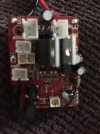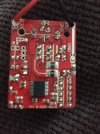Rs2k_Rider
DW's Resident Medic
Hi all. Need your help again.
I have a Syma S33 heli that's broken, see a pattern here lol
Anyways.
The main rotors turn no problem, but the tail rotor has stopped. No forward or reverse [emoji31]
I have stripped it down and taken a pic of each side of the pcb.
I suspect it's dead transistors but not sure ....


The tail rotor connection is the one in the first pic above the transistors on the bottom left.
On the other side it is on the right hand side at the top of the legs of the transistors / next to the R010 resistors.
It looks like the connector traces to the middle pins on the bottom line of transistors - these are D882P G18.
What I was wondering, is I think these have failed due to upgrades for the tail rotor (bigger motor, more powerful) so fried something. What can I replace these with that are more powerful ?
Cheers
I have a Syma S33 heli that's broken, see a pattern here lol
Anyways.
The main rotors turn no problem, but the tail rotor has stopped. No forward or reverse [emoji31]
I have stripped it down and taken a pic of each side of the pcb.
I suspect it's dead transistors but not sure ....


The tail rotor connection is the one in the first pic above the transistors on the bottom left.
On the other side it is on the right hand side at the top of the legs of the transistors / next to the R010 resistors.
It looks like the connector traces to the middle pins on the bottom line of transistors - these are D882P G18.
What I was wondering, is I think these have failed due to upgrades for the tail rotor (bigger motor, more powerful) so fried something. What can I replace these with that are more powerful ?
Cheers
